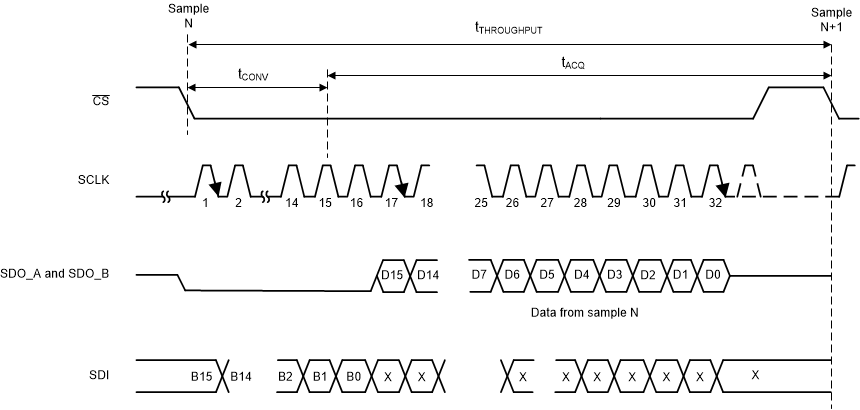ZHCSJ89B January 2019 – July 2022 ADS8353-Q1
PRODUCTION DATA
- 1特性
- 2应用
- 3说明
- 4Revision History
- 5Pin Configuration and Functions
- 6Specifications
- 7Detailed Description
- 8Application and Implementation
- 9Device and Documentation Support
7.5.3.2.1 32-CLK, Dual-SDO Mode (CFR.B11 = 0, CFR.B10 = 0, Default)
The 32-CLK, dual-SDO mode is the default mode supported by the device. This mode can also be selected by writing CFR.B11 = 0 and CFR.B10 = 0.
In this mode, the SDO_A pin outputs the ADC_A conversion result and the SDO_B pin outputs the ADC_B conversion result. Figure 7-6 shows a detailed timing diagram for this mode.
 Figure 7-6 32-CLK, Dual-SDO Mode Timing Diagram
Figure 7-6 32-CLK, Dual-SDO Mode Timing DiagramA CS falling edge brings the serial data bus out of 3-state and also outputs a 0 on the SDO_A and SDO_B pins. The device converts the sampled analog input during the conversion time (tCONV). SDO_A and SDO_B read 0 during this period. After completing the conversion process, the sample-and-hold circuit returns to sample mode. The device outputs the MSBs of ADC_A and ADC_B on the SDO_A and SDO_B pins, respectively, on the 16th SCLK falling edge. As shown in Table 7-9, the subsequent SCLK falling edges are used to shift out the rest of the bits of the conversion result.
| DEVICE | PINS | LAUNCH EDGE | ||||||||||||
|---|---|---|---|---|---|---|---|---|---|---|---|---|---|---|
| CS | SCLK | CS | ||||||||||||
| ↓ | ↓1 | — | ↓15 | ↓16 | — | ↓27 | ↓28 | ↓29 | ↓30 | ↓31 | ↓32 ... | ↑ | ||
| ADS8353-Q1 | SDO-A | 0 | 0 | — | 0 | D15_A | — | D4_A | D3_A | D2_A | D1_A | D0_A | 0 ... | Hi-Z |
| SDO-B | 0 | 0 | — | 0 | D15_B | — | D4_B | D3_B | D2_B | D1_B | D0_B | 0 ... | Hi-Z | |
In this mode, at least 32 SCLK falling edges must be given to validate the read or write frame. A CS rising edge ends the frame and puts the serial bus into 3-state.
See the Section 6.6 table for timing specifications specific to this serial interface mode.